How Do Probiotics Survive Stomach Acid?

You probably know probiotics as healthy bacteria that support gut health and provide a range of positive overall wellness benefits. But they aren’t as good to you if they’re dead. Before probiotics can work their magic, they must survive stomach acid strong enough to break down everything from meat to tough, fibrous plants. In this…
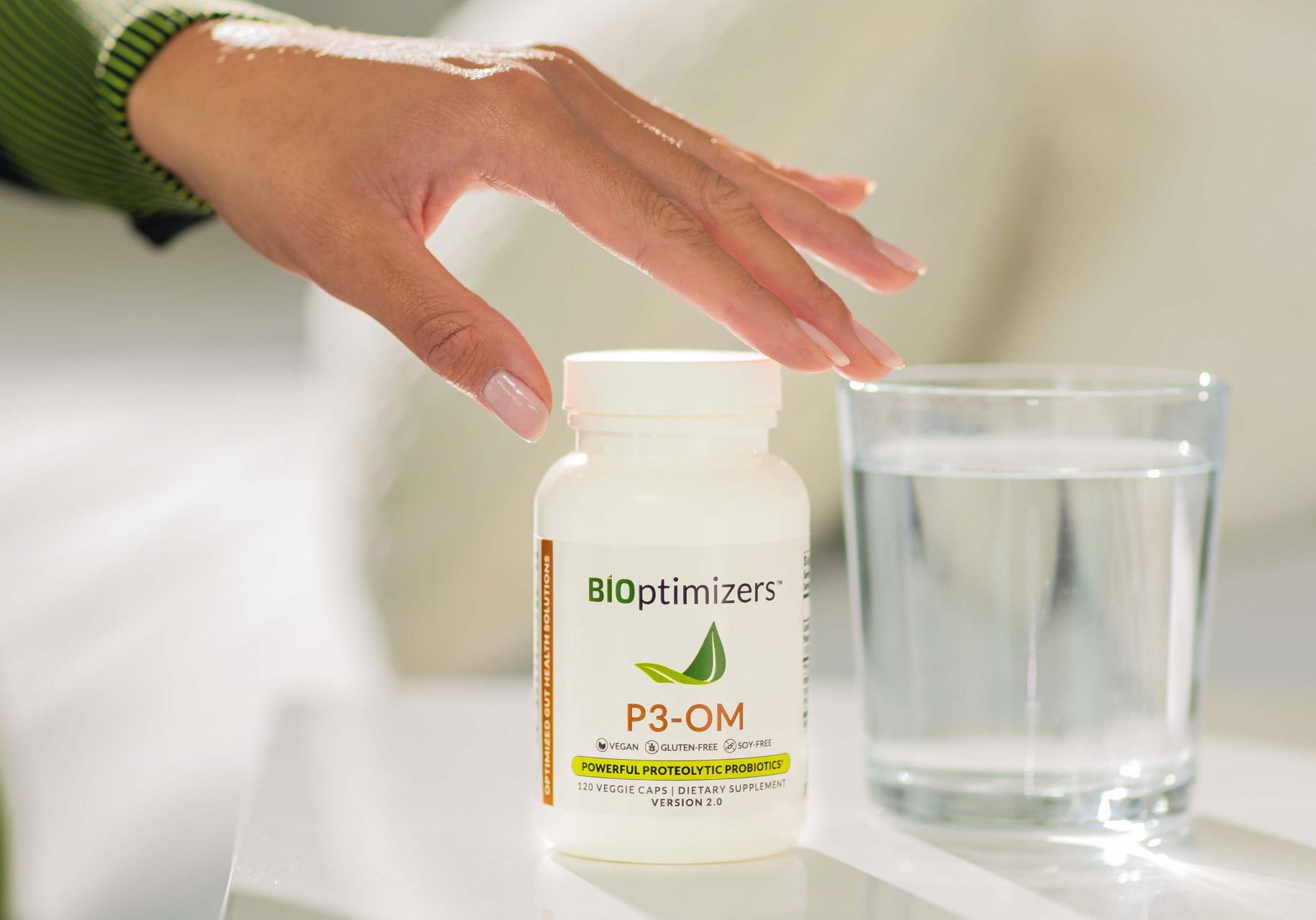
You probably know probiotics as healthy bacteria that support gut health and provide a range of positive overall wellness benefits. But they aren’t as good to you if they’re dead. Before probiotics can work their magic, they must survive stomach acid strong enough to break down everything from meat to tough, fibrous plants.
In this article, we’ll explore how probiotics survive the harsh stomach environment, what can kill them, and how you can maximize the benefits of these helpful bacteria.
How Do Probiotics Survive Stomach Acid?

Probiotics’ ultimate aim is to reach the large intestine and colon, where they can deliver health benefits. However, they encounter various hurdles within the digestive system before reaching their final destination.
Before reaching the stomach, probiotics must endure exposure to the mildly acidic saliva in the mouth. Lab studies show that such quick transit time has little effect on them.
Once probiotics move from the throat to the stomach, they face a significant challenge: stomach acid. Your stomach generally has a pH of 2.5 to 3.5, but it can get as low as 1 or 2.
| Technical background: pH stands for “power of hydrogen ions,” and it works on a log scale. The lower pH you have, the more hydrogen ions you have. pH 1 means you have 0.1 molar, which is about 0.1 gram per litre. pH 2 means you have 1/10 of that, which is 0.01 gram per litre, and so on. That means pH 3 has 1/10 hydrogen ions as pH 2 and 1/1000 hydrogen ions as pH 1. pH 3 and pH 2 are 10 times different! |
Your stomach acid can harm most bacteria, especially ones that can’t handle acid well. It reduces the pH of the cytoplasm of their cells, reducing their ability to work correctly.
Here’s the fascinating part: many probiotics, such as Bifidobacteria, Lactobacillus acidophilus, and some other strains of Lactobacilli, can survive in acids. They rely on an enzyme called F1F0-ATPase, which pumps hydrogen ions to regulate internal pH and produces energy (ATP) when encountering acid.
This enzyme becomes more active and plentiful in acidic environments, enhancing probiotics’ ability to withstand harsh conditions.
Other types of probiotics have an easier time surviving stomach acid, notably yeast-based probiotics like S. Boulardii and spore probiotics from the Bacillus genus. S. Boulardii has a heightened tolerance to acidic pH, enabling survival even at levels as low as 2.
Bacillus, spore-based probiotics, get their strength from their exterior spore coat. The spore coat is a strong, layered shield made of proteins. It helps the organism keep its shape and keeps harmful substances out, which likely helps it survive tough conditions such as stomach acid.
Probiotics generally only stay in the stomach for a short time. Still, even this period can be difficult for them because of the acid and other stomach conditions like enzymes and churning. Not all probiotics can survive. The shorter they stay in the stomach, the greater their chance of survival.
But the journey doesn’t end there. Even if probiotics survive the stomach, they must navigate through the small intestine, where alkaline fluids from the pancreas and liver (bile) can break down their outer layer and potentially harm their DNA.
If probiotics successfully navigate the challenges, they eventually reach the colon, their final destination. However, the battle isn’t over yet. They must compete with existing gut bacteria for nutrients and space to survive and/or establish themselves in the colon lining. Your body may expel them in stool shortly after consuming them due to the intense competition in your gut.
So, after all of this, it almost seems unlikely that they’ll actually survive long enough to support your health and wellness. The good news is that researchers have figured out ways to help them survive.
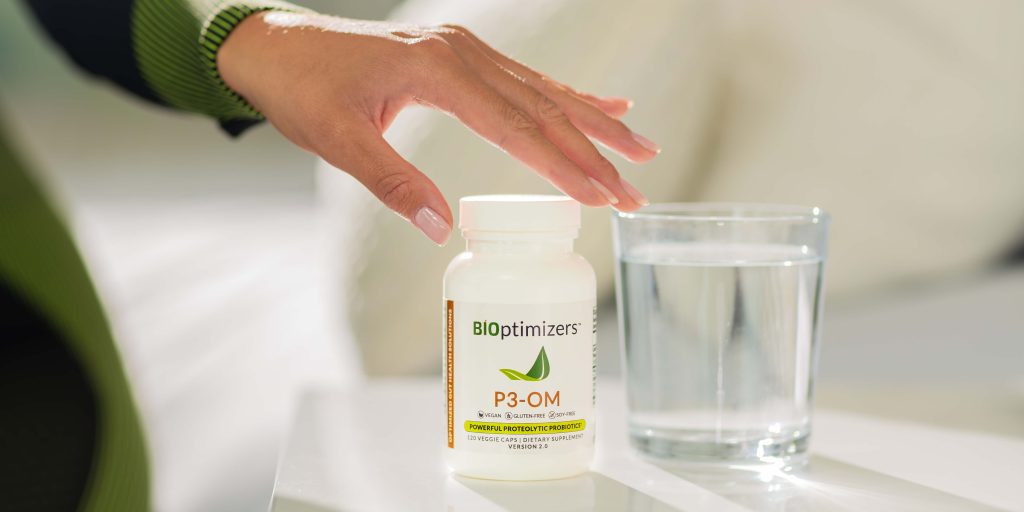
Supporting Probiotic Survival
To ensure enough probiotics reach your colon for health benefits, bacteria-based probiotic foods or supplements should have at least 10 billion colony-forming units (10,000,000,000 CFUs) per gram. This ensures that 6–7 billion CFUs per gram make it to your colon for therapeutic effects.
Other forms of probiotics have lower recommended dosages for optimal efficacy. For yeast-based S. boulardii, the recommended dosage is 1 billion CFUs. On the other hand, spore-based probiotics in the Bacillus genus are generally recommended at dosages ranging from 10 million to 1 billion CFUs.
Probiotic Form
The chances of probiotic survival can hinge on their form. In a study that simulated stomach conditions, researchers observed the survival rates of probiotics. They gauged whether the colony numbers decreased by tallying live probiotic cells before and after this simulation.
Sadly, the researchers found that out of the 11 probiotics tested, only two contained their initial labeled concentrations. If you’re buying a probiotic that doesn’t have the concentration on the label, you’re already at a disadvantage. More on that later.
Following the simulated stomach journey, most probiotics experienced a reduction in live cells, potentially diminishing their efficacy in promoting health. Notably, the probiotics that fared best after exposure to the stomach environment were those specifically from or packaged with fermented milk.
Packaging probiotics in special microcapsules creates a protective coating that shields them from stomach acid, preserving their effectiveness. These tiny microcapsules are made using natural materials such as alginate, chitosan, gelatin, whey protein isolate, or cellulose derivatives. The packaging process to make probiotics more resistant to stomach acid includes techniques like freeze-drying, extrusion, or emulsion.
Fermented milk probiotics might also keep them alive due to fat globules. Milk naturally has tiny fat droplets that can cover and protect the good bacteria from stomach acid and bile salts. If you want to reap the benefits from probiotics in your yogurt, however, choose ones that are not pasteurized or heated in any way after the fermentation process.
Our best probiotics, P3-OM, are specially packaged in vegetable cellulose to help them resist stomach acid and bile salts. Our R&D department found that P3-OM showcased impressive performance compared to competitors regarding pH tolerance and bile resistance.
At pH 2, P3-OM showed no growth, similar to most competitors, except for one containing digestive enzymes. Additionally, P3-OM demonstrated superior growth at pH 3 and thrived alongside other probiotics at pH 4. Although P3-OM showed limited growth in high bile concentrations, P3-OM excelled in lower bile concentrations, emphasizing its resilience and adaptability.
How Do You Know If Probiotics Are Alive?

Probiotics might not work as well if they’re not handled right during processing, storage, or transportation. Factors that can affect their viability include:
- Temperature changes
- Acidity
- Light
- High heat
- Radiation such as X-rays and the sun’s radiation
- Too much oxygen
Moisture can also affect probiotics by making bacteria start working too soon.
So, with all these risk factors, is there a way to tell if your probiotics are still alive? You may have heard of the probiotics milk test. It goes like this:
Step 1: Pour 4 ounces of cold milk into a glass. For those who avoid dairy, we also have a coconut meat vegan yogurt recipe.
Step 2: Add the probiotic capsules or powder and mix well.
Step 3: Cover the glass with plastic wrap, ensuring it touches the milk to prevent oxygen from getting in.
Step 4: Keep the glass near 98°F, even in sunlight if needed.
Step 5: Check after 24-48 hours to see if the milk has curdled.
Unfortunately, it’s not a great way to see if all your probiotics are still alive. While it may indicate that some of your probiotics are working, like streptococcus thermophilus and Lactobacillus, which can ferment lactose and produce lactic acid, not all strains of probiotics will respond to milk.
The only surefire way to know that probiotics are still alive is through lab testing, and that’s not realistic for a typical consumer.
The best way to ensure that you’re getting high-quality living probiotics is by purchasing them from a company that can guarantee their viability and back them up with testing.
At BIOptimizers, we test our supply chains by sending the first orders to our own homes and then re-testing the delivered products in the lab to see if they survive the supply chain.
If you want to skip all that and just dive in and try out the probiotics, here are some physical signs that they’re working. Within a few days, you might notice:
- Improved digestion and regularity
- Less bloating and abdominal discomfort
- Improved mood and cognitive function
Learn more about how long it takes probiotics to work in this article.
What Can Kill Probiotics?
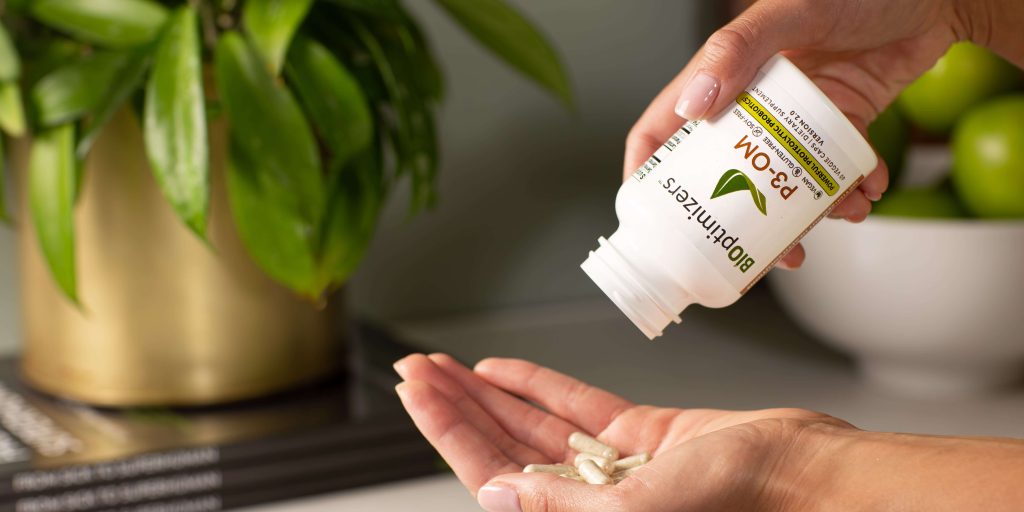
Once you’ve made the investment in probiotics, you want to do your best to keep them alive. Let’s look at some factors you should consider.
Heat
One way to maximize the benefits of probiotics is to keep them cool. This also applies to shelf-stable probiotics. Yes, probiotics like P3-OM are made to last through freeze-drying without refrigeration, but storing them in a cool, dry place is always best.
The temperature at which probiotics die changes depending on the strain and form of the probiotic. For instance, probiotics found in yogurt can significantly diminish when exposed to room temperature for a mere six hours, as shown in a study investigating the impact of temperature on probiotic yogurt. [R15]
Yogurt with Lactobacillus johnsonii and Lacticaseibacillus rhamnosus both had fewer live bacteria after being at room temperature for six hours, and even less after 24 hours. The third yogurt with Lactobacillus acidophilus kept only about half of its live bacteria after six hours at room temperature and just a quarter after 24 hours. [R15]
Recent research shows that heating probiotics for a short time might make them better at fighting suboptimal bacteria. Researchers heated five different strains of lactic acid bacteria, including [R16]:
- Lactiplantibacillus plantarum
- Two strains of Lacticaseibacillus casei
- Two strains of Levilactobacillus brevis
The strains reached a temperature of 80°C (176°F) for 5, 15, or 30 minutes. They tested their stickiness and ability to clump together and stop bad bacteria like Staphylococcus aureus and Listeria from sticking to the stomach lining. Heating for 5 and 15 minutes actually made the probiotics stickier, and they were better at stopping bad bacteria from sticking than non-heated ones.
Another study combining data from 40 trials involving nearly 4,000 people compared heat-killed probiotics to live ones. They found that modified probiotics were mostly as effective as live ones, and in 15% of treatment trials, they worked even better. Side effects were similar between the two types, but reporting varied.
Because there weren’t enough consistent studies, it’s hard to definitively say how effective heat-killed probiotics compare to living strains. It does, however, provide some encouragement that probiotics exposed to heat still have beneficial effects or different sets of health benefits altogether.
Regardless, we encourage you to follow the storage instructions provided by your probiotic manufacturer to maintain viability.
Antibiotics
Antibiotics are designed to kill bacteria, and that includes probiotics. To be safe, we recommend taking probiotics at least an hour away from any antibiotics.
Stomach Acid (If Taken Too Close to Eating)
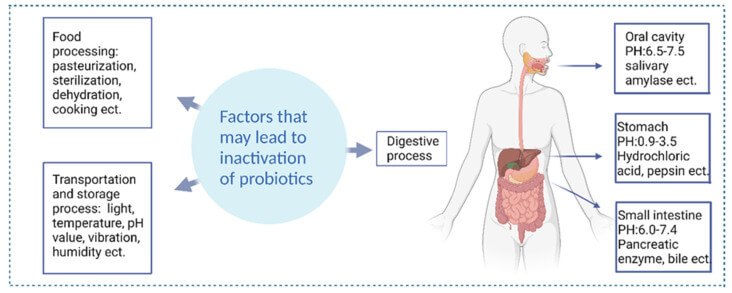
To help get probiotics through your stomach and into your colon intact, it’s important to take them apart from eating if possible. When food enters your stomach, your gut secretes digestive enzymes and acid in about 30 minutes. This creates an even harsher environment, making it harder for the probiotics to survive.
Using a model stomach, researchers tested the viability of probiotics based on timing and food type. Counting bacteria before and after passing through the stomach model showed improved survival with meal ingestion or 30 minutes before. Taking them 30 minutes after reduced survival.
Milk with 1% fat and oatmeal-milk gruel supported better survival than apple juice or spring water. The fat content in the meal seemed more important for bacteria survival than its protein content. Particularly for non-encapsulated probiotics, it’s best to take them with or just before a meal containing some fats for optimal effectiveness.
How to Maximize the Benefits of Probiotics
Take Them With Prebiotics
Probiotics are beneficial bacteria, while prebiotics are fibers that nourish them. Combined, they form synbiotics, enhancing gut health by supporting probiotic growth and survival. Synbiotics offer superior effects on gut flora compared to probiotics or prebiotics alone.
Learn more about how probiotics work to provide additional probiotic benefits in this article.
On an Empty Stomach
We recommend taking probiotics 30-60 minutes before breakfast or before bed. This helps ensure that your probiotics aren’t exposed to the harshest stomach acid release 30 minutes into a meal. An empty stomach will help get them to your colon quickly and begin colonizing.
This blog post will tell you more about when you should take probiotics.
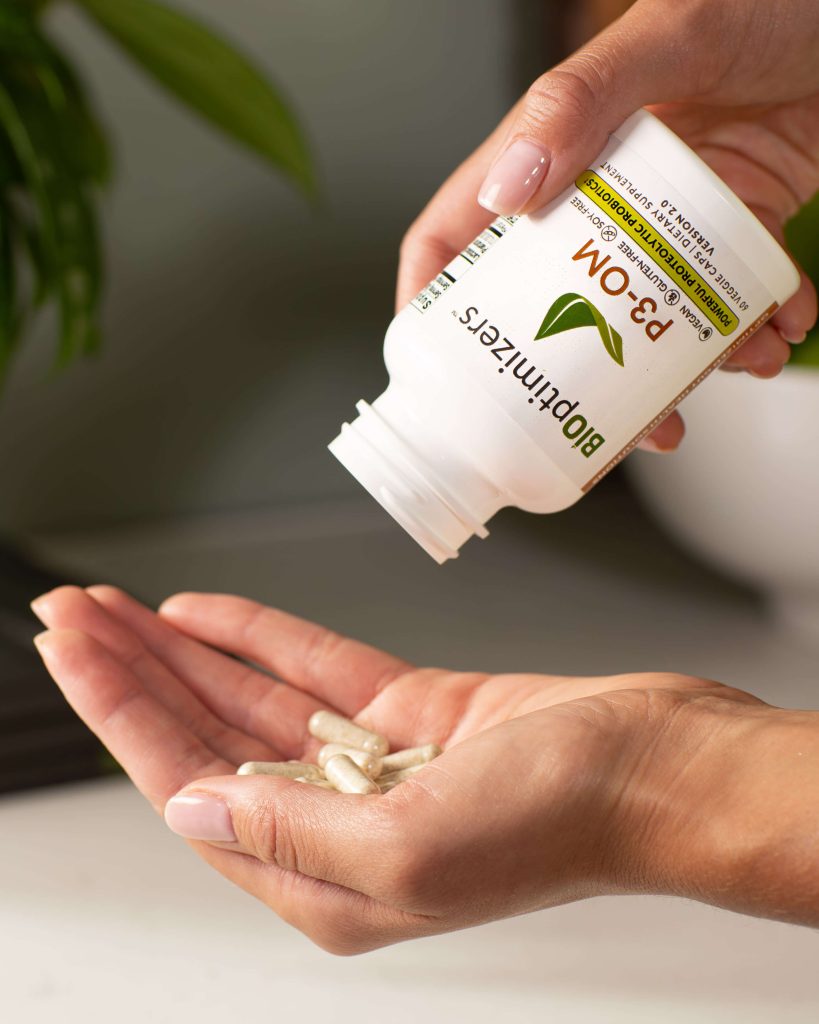
Proper Storage
We already discussed this above, but it’s important, so it bears repeating. First, pay attention to the storage instructions on your probiotics and follow the manufacturer’s advice. They should know the strains better than anyone and know how those strains will respond to various conditions.
Shelf-stable probiotics, like P3-OM, are made to survive long-term without refrigeration and should be stored in a cool, dry place.
Conclusion
Probiotics are crucial for gut health, but surviving the digestive system is key. Here are some tips and strategies to ensure you get the most out of your probiotic:
- Choose an encapsulated probiotic supplement like P3-OM that includes prebiotics for improved survival and supports probiotic growth.
- Take probiotics on an empty stomach or before bed to reduce exposure to stomach acid.
- Follow the manufacturer’s storage instructions for optimal viability.
- García-Ruiz A, González de Llano D, Esteban-Fernández A, Requena T, Bartolomé B, Moreno-Arribas MV. Assessment of probiotic properties in lactic acid bacteria isolated from wine. Food Microbiol. 2014;44:220-225. doi:10.1016/j.fm.2014.06.015
- Haukioja A, Yli-Knuuttila H, Loimaranta V, et al. Oral adhesion and survival of probiotic and other lactobacilli and bifidobacteria in vitro. Oral Microbiol Immunol. 2006;21(5):326-332. doi:10.1111/j.1399-302x.2006.00299.x
- Han S, Lu Y, Xie J, et al. Probiotic gastrointestinal transit and colonization after oral administration: A long journey. Front Cell Infect Microbiol. 2021;11. doi:10.3389/fcimb.2021.609722
- de Paula BP, Chávez DWH, Lemos Junior WJF, et al. Growth parameters and survivability of Saccharomyces boulardii for probiotic alcoholic beverages development. Front Microbiol. 2019;10. doi:10.3389/fmicb.2019.02092
- Driks A. Maximum shields: the assembly and function of the bacterial spore coat. Trends Microbiol. 2002;10(6):251-254. doi:10.1016/s0966-842x(02)02373-9
- Naissinger da Silva M, Tagliapietra BL, Flores V do A, Pereira dos Santos Richards NS. In vitro test to evaluate survival in the gastrointestinal tract of commercial probiotics. Curr Res Food Sci. 2021;4:320-325. doi:10.1016/j.crfs.2021.04.006
- Sun Q, Yin S, He Y, Cao Y, Jiang C. Biomaterials and encapsulation techniques for probiotics: Current status and future prospects in biomedical applications. Nanomaterials (Basel). 2023;13(15):2185. doi:10.3390/nano13152185
- McFarland LV. Systematic review and meta-analysis ofSaccharomyces boulardiiin adult patients. World J Gastroenterol. 2010;16(18):2202. doi:10.3748/wjg.v16.i18.2202
- Duc LH, Hong HA, Barbosa TM, Henriques AO, Cutting SM. Characterization of Bacillus probiotics available for human use. Appl Environ Microbiol. 2004;70(4):2161-2171. doi:10.1128/aem.70.4.2161-2171.2004
- Huq T, Khan A, Khan RA, Riedl B, Lacroix M. Encapsulation of probiotic bacteria in biopolymeric system. Crit Rev Food Sci Nutr. 2013;53(9):909-916. doi:10.1080/10408398.2011.573152
- Talwalkar A, Kailasapathy K. The role of oxygen in the viability of probiotic bacteria with reference to L. acidophilus and Bifidobacterium spp. Curr Issues Intest Microbiol. 2004;5(1).
- Pedersen N, Andersen NN, Végh Z, et al. Ehealth: Low FODMAP dietvs Lactobacillus rhamnosusGG in irritable bowel syndrome. World J Gastroenterol. 2014;20(43):16215. doi:10.3748/wjg.v20.i43.16215
- Di Stefano M, Miceli E, Armellini E, Missanelli A, Corazza GR. Probiotics and functional abdominal bloating. J Clin Gastroenterol. 2004;38(Supplement 2):S102-S103. doi:10.1097/01.mcg.0000128939.40458.25
- Sarkar A, Lehto SM, Harty S, Dinan TG, Cryan JF, Burnet PWJ. Psychobiotics and the manipulation of bacteria–gut–brain signals. Trends Neurosci. 2016;39(11):763-781. doi:10.1016/j.tins.2016.09.002
- Scharl M, Geisel S, Vavricka SR, Rogler G. Dying in yoghurt: The number of living bacteria in probiotic yoghurt decreases under exposure to room temperature. Digestion. 2011;83(1-2):13-17. doi:10.1159/000308715
- Karbowiak M, Gałek M, Szydłowska A, Zielińska D. The influence of the degree of thermal inactivation of probiotic lactic acid bacteria and their postbiotics on aggregation and adhesion inhibition of selected pathogens. Pathogens. 2022;11(11):1260. doi:10.3390/pathogens11111260
- Tompkins T, Mainville I, Arcand Y. The impact of meals on a probiotic during transit through a model of the human upper gastrointestinal tract. Benef Microbes. 2011;2(4):295-303. doi:10.3920/bm2011.0022
- Vyas U, Ranganathan N. Probiotics, prebiotics, and synbiotics: Gut and beyond. Gastroenterol Res Pract. 2012;2012:1-16. doi:10.1155/2012/872716






